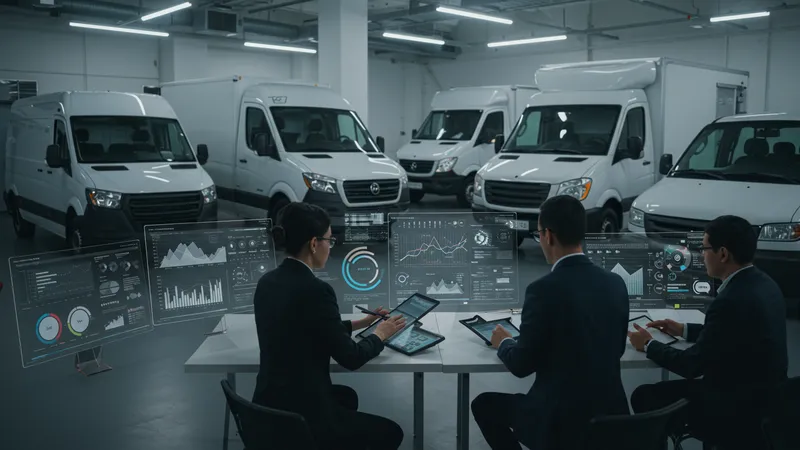

For modern businesses, managing a large number of vehicles is a serious logistical challenge. This is where specialized divisions within major automotive retailers come into play, focusing entirely on commercial clients. Through tailored services, business-focused fleet programs support companies in overseeing their vehicle assets—whether those assets are delivery vans, service pickups, or corporate cars. The goal is not just providing vehicles, but creating mobility solutions that boost efficiency and support business growth from the ground up.
Behind these divisions lies a detailed system of support: consulting on fleet composition, arranging financing or leases, offering maintenance packages, and deploying telematics for performance tracking. These services are designed for businesses of all sizes, from startups scaling their first delivery routes to multi-national corporations seeking unified purchasing. The division acts as a dedicated partner, streamlining every step from selection to retirement of vehicles, often providing volume discounts, priority service, and analytics unavailable through standard retail channels.

These divisions stand apart due to their use of data-driven insights and business intelligence—not only helping customers choose the right vehicles, but also giving detailed reports on usage trends, costs, and performance. By bundling management services with vehicle supply, businesses gain a consistency that reduces overall administrative burden and keeps fleets running smoothly. Consultations often help clients avoid costly mistakes, optimize fleet size, and select models that meet regulatory or environmental standards.
One competitive advantage for commercial fleet retail divisions is scalable service. As a business expands, the division’s program can adapt seamlessly to new vehicles, changing routes, or emerging needs. Centralized billing and single-point-of-contact support further streamline operations, making it easier for companies to forecast expenses and maintain productivity.
Additionally, commercial-focused partnerships with OEMs and suppliers mean that fleet divisions secure favorable pricing and early access to new or customized models. This benefits businesses looking for specialized configurations—such as cargo upfits or hybrid options—and translates into higher value with lower lifecycle costs.
Technological integration is another signature feature. Leverage of telematics, driver safety programs, and predictive maintenance scheduling give businesses real-time control over their fleets, reducing downtime and supporting compliance. This ability to monitor vehicles remotely and optimize routes is central to modern business mobility strategies.
In summary, fleet and commercial vehicle retail divisions for business clients offer much more than simple vehicle sales or leases. The blend of analytics, support, and tailored solutions turns them into strategic partners. Yet, each program brings nuanced differences worth exploring. The deeper details reveal even more valuable insights ahead, from contract flexibility to long-term cost management—an essential read for decision-makers aiming to drive their business forward.
Understanding the main service categories within fleet and commercial vehicle retail divisions clarifies how these providers support business mobility. These categories typically include acquisition and leasing, maintenance management, telematics, and vehicle remarketing at end of life. Each addresses a key aspect of fleet ownership, working together to simplify the entire vehicle lifecycle for business clients. By segmenting services, these divisions can customize packages that match the unique workflows and budgets of different industries.

For acquisition and leasing, programs such as LeasePlan’s flexible solutions allow clients to rapidly update vehicle types or quantities with minimal disruption. This enables businesses to scale up or pivot without being locked into long contracts or unsupported assets. Maintenance management, often bundled as part of the monthly fee, ensures that routine service and repairs are centrally administered, minimizing downtime and smoothing out operational costs over time.
Telematics and fleet analytics represent one of the fastest-growing categories within fleet services. Providers like Enterprise and Element integrate GPS, diagnostics, and driver behavior analytics to help companies optimize routes, monitor safety, and reduce fuel costs. Through real-time dashboards and reporting, managers receive actionable data that leads to more informed decisions and measurable productivity gains.
When vehicles are ready for replacement, remarketing and end-of-life services become essential. Commercial fleet divisions handle resale, disposal, or buybacks, helping clients maximize residual value and simplify administrative procedures. By supporting businesses through every phase, these divisions offer an all-in-one mobility management experience that continues to evolve with new technology and client expectations.
Different cost structures offered by fleet and commercial vehicle retail divisions greatly affect total expenditures and financial predictability for business clients. Enterprise, Element, and LeasePlan each package services differently—ranging from all-inclusive monthly rates to customized billing. Most programs aim to spread costs evenly, factoring in depreciation, maintenance, taxes, and telematics. This structure gives decision-makers a transparent overview, making annual budgeting simpler and supporting long-term profitability calculations.

For instance, LeasePlan’s monthly fee includes vehicle lease, standard servicing, and mileage tolerance, which means fewer surprise costs for businesses managing fluctuating vehicle usage. Enterprise’s per-vehicle pricing model is praised for flexibility, allowing clients to swap or scale fleet vehicles without financial penalties. This pay-as-you-go style is well suited to industries with seasonal variations or rapid growth.
Element’s integrated approach incorporates not just direct costs but also advanced analytics and compliance solutions, sometimes priced as subscription add-ons. This approach is particularly useful for larger operations seeking layered management tools. For smaller businesses, basic packages focus on essential compliance, maintenance, and acquisition, keeping entry costs relatively low while permitting easy upgrades as needs change.
Ultimately, choosing the right cost structure depends on the specific mix of vehicles, usage profile, service needs, and desired predictability. By comparing these models, business clients are better positioned to balance operational efficiency with financial discipline, ensuring the fleet program supports both current demands and future scaling.
The integration of advanced technology within fleet and commercial vehicle retail divisions transforms the way businesses track, manage, and optimize vehicle assets. Major providers leverage telematics platforms, IoT hardware, and cloud-based analytics to give clients real-time visibility of vehicle locations, driver performance, and maintenance status. These digital features are now critical to driving efficiency and regulation compliance in modern fleets.

Enterprise’s and LeasePlan’s systems enable live monitoring via mobile apps and dashboards, sending proactive alerts to facility or fleet managers. This not only streamlines response during incidents but also supports proactive scheduling of preventive maintenance, reducing downtime and costly repairs. Data-driven safety programs help identify high-risk behaviors and encourage safer driving, which can lead to insurance savings and improved employee well-being.
Element’s comprehensive analytics suite goes even further, allowing businesses to benchmark performance across divisions or regions. With insights into fuel consumption, idle time, and route optimization, logistics-heavy operations can see tangible reductions in fuel spend and greenhouse emissions. Accurate, up-to-date records also simplify compliance reporting for tax and regulatory filings.
Adapting to emerging technologies, such as electric vehicle (EV) platforms and autonomous driving trials, keeps fleet programs future-ready. Leaders in this space offer support for EV infrastructure planning and integration with renewable energy sources—crucial for organizations targeting sustainability goals. As mobility continues to evolve, seamless technology integration ensures businesses stay competitive and operationally agile.
Enrolling in a dedicated fleet and commercial vehicle retail program delivers sustained value that extends far beyond initial vehicle supply. Businesses gain access to economies of scale, whether purchasing or leasing in bulk, resulting in lower acquisition costs and enhanced bargaining power. This approach transforms vehicle management from an administrative hassle into a streamlined process, freeing teams to focus on core business priorities instead of logistics concerns.

Trends show a rising emphasis on sustainability, with providers expanding support for electric and low-emission vehicles. Fleet solutions now incorporate charging infrastructure planning and predictive analytics to help businesses monitor carbon output. These changes reflect growing regulations and customer expectations, making it easier for companies to lead in sustainable business practices without sacrificing operational efficiency.
Collaboration is another key benefit: fleet divisions often convene forums, training, and consultative workshops to keep clients informed of new legislation, technology advances, or industry best practices. This knowledge-sharing element ensures continued evolution, supporting clients in adapting fleet strategies for evolving market conditions and global supply chain dynamics.
Most notably, the long-term partnership model ensures consistent service, access to new innovations, and adaptable contract terms. Businesses are better equipped to weather economic fluctuations, regulatory changes, or emerging transportation technologies, making the modern fleet and commercial vehicle division an essential ally in business mobility for the foreseeable future.